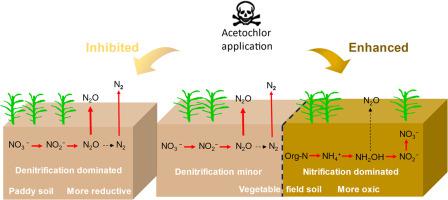Soil and Tillage Research ( IF 6.1 ) Pub Date : 2021-10-29 , DOI: 10.1016/j.still.2021.105231 Juhua Yu 1 , Jin Zhang 1 , Xiangzhou Zheng 1 , Yushu Zhang 1 , Deli Chen 2 , Hong Ding 1

|
To boost grain yield, land use conversion and herbicide application are commonly considered two primary anthropogenic interventions to microbe-mediated nitrogen (N) cycling of soils. However, the coupling effects of land use and herbicide acetochlor application on soil N cycle are still poorly understood although separate role had been extensively investigated. A 31-day laboratory batch experiment on bacterial communities associated with N metabolism in soil collected from various land use types were carried out under acetochlor application using classic dilution plating method. The results showed soil characteristic changes induced by land-use strongly influenced soil bacterial communities, and pH, nitrate (NO3−-N) contents were the best predictors for nitrifying bacteria (p < 0.05). Soil nitrifying bacteria was the dominant species in vegetable fields (VF30 and VF70), whereas denitrifying bacteria was the keystone species in paddy field cultivated over 100 years (PF100), resulting in mean nitrification potentials of vegetable fields approximately 3 times that of PF100 (p < 0.05). Rather, a dosage of 10 mg kg–1 acetochlor application inhibited denitrification potentials in all three soils (p < 0.05), and had negligible impact on nitrification potentials. This could be attributed to decreases in abundance and activity of denitrifying bacteria after acetochlor application. Therefore, acetochlor application was capable of decreasing denitrification of N removal from soils to atmosphere, and vegetable cultivation enhanced transformation of ammonium (NH4+-N) to NO3−-N species in comparison to paddy field. Our findings renew functional differentiations of land use and herbicide acetochlor application on soil N cycling, and give insight for soil N nutrient management in agricultural practices to ensure food security and improve environmental sustainablility.
中文翻译:

土地利用驱动的土壤特性变化的不同调节和除草剂乙草胺对土壤氮循环的影响
为了提高粮食产量,土地利用转化和除草剂施用通常被认为是对微生物介导的土壤氮 (N) 循环的两种主要人为干预。然而,土地利用和除草剂乙草胺施用对土壤氮循环的耦合作用仍然知之甚少,尽管已经广泛研究了各自的作用。使用经典的稀释电镀方法在乙草胺施用下对从各种土地利用类型收集的土壤中与氮代谢相关的细菌群落进行了为期 31 天的实验室批量实验。结果表明,土地利用引起的土壤特征变化对土壤细菌群落、pH 值、硝酸盐(NO 3 --N) 含量是硝化细菌的最佳预测因子 (p < 0.05)。土壤硝化细菌是菜地的优势种(VF30和VF70),反硝化细菌是100多年耕作稻田的基石种(PF100),导致菜地平均硝化潜力约为PF100的3倍(p < 0.05)。相反,剂量为 10 mg kg –1乙草胺的施用抑制了所有三种土壤中的反硝化潜力(p < 0.05),并且对硝化潜力的影响可以忽略不计。这可能归因于施用乙草胺后反硝化细菌的丰度和活性降低。因此,与稻田相比,施用乙草胺能够降低土壤中氮向大气中的脱氮作用,蔬菜种植增强了铵 (NH 4 + -N) 向 NO 3 - -N 物种的转化。我们的研究结果更新了土地利用和除草剂乙草胺施用对土壤氮循环的功能差异,并为农业实践中的土壤氮养分管理提供了见解,以确保粮食安全和改善环境可持续性。











































 京公网安备 11010802027423号
京公网安备 11010802027423号